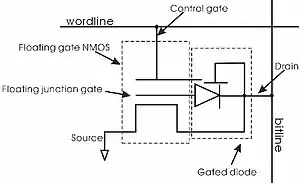| Computer memory and data storage types |
|---|
| Volatile |
| Non-volatile |
FJG RAM, short for Floating Junction Gate Random Access Memory, is a type of computer memory invented and subsequently patented in July 2009 by Oriental Semiconductor Electronics, Ltd.[1][2]
The FJG RAM, according to Oriental Semiconductor researchers has an ultra-compact cell area of 4-5F2 (F refers to feature size) and a capacitor-less cell configuration. The FJG RAM can be produced in existing standard DRAM fabs. Due to the absence of a capacitor, the FJG cell process is more compatible with logic processes, allowing its use in standalone DRAM applications as well as embedded-DRAM applications. Other properties include non-destructive-read and the possibility for DRAM designers to use shared sense amplifiers to reduce the complexity of peripheral circuits.[2]
As of July 2023, there is little evidence of ongoing development or near-term commercialization efforts.

References
- ↑ "Emerging Memory Technologies - VLSI Tutorials - Mepits". www.mepits.com. Archived from the original on 2016-06-03. Retrieved 2023-03-31.
- 1 2 Wang, Pang-Fei. "Capacitorless Dram Cell With Floating Junction Gate". www.growthconsulting.frost.com. Archived from the original on 2015-08-15. Retrieved 2023-03-31.